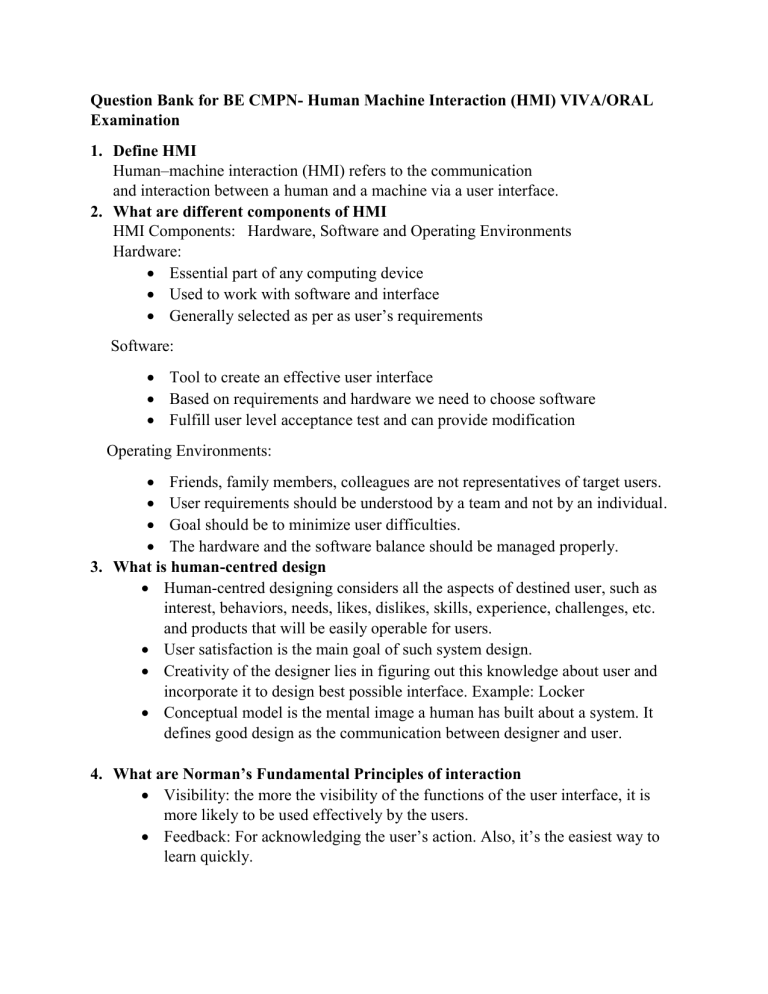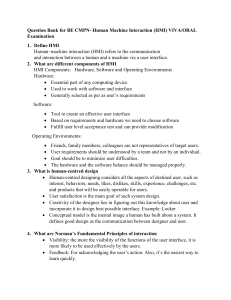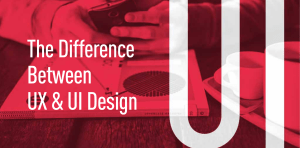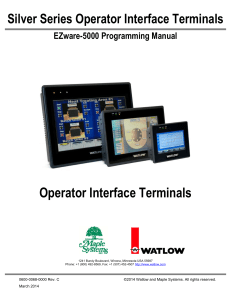
Question Bank for BE CMPN- Human Machine Interaction (HMI) VIVA/ORAL Examination 1. Define HMI Human–machine interaction (HMI) refers to the communication and interaction between a human and a machine via a user interface. 2. What are different components of HMI HMI Components: Hardware, Software and Operating Environments Hardware: Essential part of any computing device Used to work with software and interface Generally selected as per as user’s requirements Software: Tool to create an effective user interface Based on requirements and hardware we need to choose software Fulfill user level acceptance test and can provide modification Operating Environments: Friends, family members, colleagues are not representatives of target users. User requirements should be understood by a team and not by an individual. Goal should be to minimize user difficulties. The hardware and the software balance should be managed properly. 3. What is human-centred design Human-centred designing considers all the aspects of destined user, such as interest, behaviors, needs, likes, dislikes, skills, experience, challenges, etc. and products that will be easily operable for users. User satisfaction is the main goal of such system design. Creativity of the designer lies in figuring out this knowledge about user and incorporate it to design best possible interface. Example: Locker Conceptual model is the mental image a human has built about a system. It defines good design as the communication between designer and user. 4. What are Norman’s Fundamental Principles of interaction Visibility: the more the visibility of the functions of the user interface, it is more likely to be used effectively by the users. Feedback: For acknowledging the user’s action. Also, it’s the easiest way to learn quickly. Constraints: It will prevent the user from making mistakes. Won’t allow to perform a particular action if it’s a wrong operation. Example: Date Affordance:Visual clues that lead the user to understand functionality of the object. Example: By looking at the door we know how it is going to open Mapping: To present the relationship between two objects is mapping Consistency 5. What is affordance in interaction Affordances are how we perceive environments as ways to afford us our needs. Visual clues that lead the user to understand functionality of the object. Example: By looking at the door we know how it is going to open 6. What are seven stages of action Forming the goal Execution Forming the intention (plan) Specifying an action (specify) Executing the action (perform) Evaluation Perceiving the state of the world (perceive) Interpreting the state of the world (reflect) Evaluating the outcome (compare) 7. What are three level of processing in interaction Three level of processing in interaction Visceral level a) Initial level of processing information b) In this step of processing, humans reacts to audio visual actions and other aspects of a product. c) Refers to creating best user interface and graphical appearance Behavioral level a) More detailed product version than visceral b) Semantics and usability practices are addressed in this level c) Decides the behavior and feedback given by the product Reflective level a) The final level of processing involving analysis and reflection is done at this level 8. What is interaction? Communication or direct conversion or involvement with someone or something 9. What are phases of execution-evaluation cycle Establishing the goal Forming the interaction Specifying the action sequence Executing the action Perceiving the system state Interpreting the system state Evaluating the system state with respect to the goals and intentions 10. What is ergonomics It mainly represents the study of people in their working environment. For example, ergonomics is often used to create comfortable workstations for employees. This may involve choosing customized desks and chairs that fit each individual's body type. It may also include providing employees with ergonomic keyboards and wrist rests that provide better typing posture. 11. What are different types of interaction styles Types of Interaction Styles: Command line interface Menus Natural language Question/Answer and query dialog Form-fills and spreadsheets WIMP Point and click Three-dimensional interface 12. What are elements of WIMP interface WIMP stands for windows, icons, menus and pointers 13. What are common mistakes performed by people while designing computer system Developers expect people to think like computers. Developers ask users to perform difficult operations which may be easy for developers, but not so much for the users. The resultant software design will have poor behaviour as users are not taken into consideration while designing the system. 14. What are different types of responses to poor design Psychological Confusion: Since the framework and complex operations couldn’t be understood by normal users. Annoyance/Frustration: Inconsistence in design, slow computer reaction times, difficulties in quickly finding information and unexpected computer responses. Panic or Stress: unexpectedly long delays times of severe or unusual pressure may introduce panic or stress. Boredom: Slow response time or long download time. Physical Abandonment of the system: The system is rejected, and other information sources are relied upon. Partial use of the system: only a portion of the system capabilities are used. Indirect use of the system: the intermediary is placed between the would-be user and computer. Modification of the task: task is change to match the capability of system. Misuse of the system: rules are bent to shortcut operational difficulties. Direct programming: The system is reprogrammed by its user to specific needs. 15. What are different human characteristics in design Perception: It’s our awareness and understanding of the elements and object of our environment through the physical sensation of our various sense, including sight, sound, smell etc. or user experience. Memory: Anyone who forgotten important day or birthday. Sensory storage: Collecting information from our senses automatically. Visual acuity: the capacity of eye to resolve details is called visual acuity. Foveal and peripheral vision: Fovea is used to focus directly on something, peripheral vision senses anything in the area surrounding the location we are looking at, but it’s not clearly visual. Mental model: It is simply an internal representation of a person’s current understanding of something. Learning: allows skills acquired. Individual differences The user’s knowledge and experience Computer literacy: highly technical or experienced System experience: method of interaction Application experience: high, moderate or low knowledge of similar system. Task experience: level of knowledge of task Other system use: frequently or infrequent use Education: Reading level Typing skill Native language and culture The user’s Psychological characteristics Attitude and Motivation Patience Stress level Expectations Cognitive style The user’s Physical characteristics Age Gender Handedness Disabilities 16. What are different human considerations I design 17. What is design A design is a plan or specification for the construction of an object or system or for the implementation of an activity or process, or the result of that plan or specification in the form of a prototype, product or process. 18. What are steps to process of design Requirements- What is wanted: The firs step is establishing what exactly needed. Example how do people currently watch movies? What sort of personal applications do they currently use? Analysis: The results of observation and interview need to be ordered in some way to bring out key issues and communicate with later stages of design. Design: There is a central stage when you move from what you want, to how to do it. Iteration and prototyping: Humans are complex and cannot expect to get designs right first time. So, it need to evaluate a design to see how well it is working. Implementation and deployment: Finally, when we are happy with our design, we need to create it and deploy it. Writing documentation and manuals. 19. What is software life cycle Requirement Specification: Designer & customer try to capture a description of what the eventual system will be expected to provide. It involves customer work environment, domain, final product functions. Architectural Design: How the system provides the services expected from it. Details Design: Those components that are not already available for immediate integration, the designer must provide a sufficiently detailed description so that they may be implemented in some programming language. Coding and Unit testing: Coding component can be tested to verify that it performs correctly, according to some test criteria that were determined in earlier activities. Integration and testing: Once enough components have been implemented and individually tested, they must be integrated as described in the architectural design. Further testing is done to ensure correct behavior and acceptable use of any shared resource. Maintenance: After product release, all work on the system is considered under the category of maintenance, until such time a new version of product demands a total redesign, or the product is phased out entirely. 20. What is usability engineering Usability engineering is a field that is concerned generally with human–computer interaction and specifically with devising human–computer interfaces that have high usability or user friendliness. It provides structured methods for achieving efficiency and elegance in interface design. 21. What are different types of prototyping 22. What are different design rules to support usability The most abstract design rules are general principles, which can be applied to the design of interactive system in order to promote its usability. The principles are divided into three main categories. 1. Learnability: Easy to learn to new user Predictability: support for user to determine the effect of future action based on the past interaction history. Synthesizability: support for the user to access the effect of past operation. Familiarity: real world knowledge can be applied for interacting Generalizability: support for the user to extend knowledge of specific interaction Consistency: likeness in similar task objective 13. Flexibility: User and system exchange information Dialog initiative: allowing the user freedom from artificial constrain on the input dialogue imposed by the system. Multi-threading: System support user interaction to more than one task at a time Task migratability: task can be shared between the user or system. Substitutivity: allowing equal and values of input and output would be arbitrarily substitute for each other. Customizability: modification of the user interface by the user or system 14. Robustness: Level of support provided to user Observability: to evaluate the internal state of the system from previously representation Recoverability: user to take corrective action once an error has been recognised Responsiveness: how the user perceive the rate of communication with the system Task conformance: System services support to all the task the user wishes to perform and understand them 23. Enlist any 4 Shneiderman’s golden rules (8 golden rules) Strive for consistency Enable frequent users to use shortcuts Offer informative feedback Design dialogs to yield closure Offer error prevention and simple error handling Permit easy reversal of actions Support internal locus of control Reduce short term memory load 24. What are different phases of goal directed design process 25. What is direct manipulation Direct manipulation is a style of Human Machine Interaction (HMI) design which features a natural representation of task objects and actions promoting the notion of people performing a task themselves (directly) not through an intermediary like a computer Direct manipulation (DM) is an interaction style in which users act on displayed objects of interest using physical, incremental, reversible actions whose effects are immediately visible on the screen It is certainly dependent on the user being in primary control of changes in the interface. Example: Desktop. 26. What is GUI 27. What are the characteristics of GUI Sophisticated visual presentation: Pick and click interaction Restricted set of interface options Visualization Object orientation o Collection o Constraints o Composites o Container Use of recognition memory Concurrent performance of functions 28. What are principles of user interface design Visual pleasing Availability Clarity Compatibility Configurability Directness Efficiency Familiarity Flexibility Forgiveness Predictability Recovery Responsiveness Simplicity Transparency 29. Differentiate between GUI and Web user interface 30. What are different design goals Reduce visual work Reduce intellectual work Reduce memory work Reduce motor work Minimize or eliminate any burdens or instructions imposed by technology. 31. What are different ways to order screen data and contents 32. What are different ways for information retrieval on web Reading on web 1. Initial focus of attention 2. Page perusal: Focusing on the page’s content, some studies show that the user’s eyes are first drawn to the page’s text, particularly headings, captions, summaries, and notes. Scanning guidelines: • Organize content in a logical, systematic and obvious way. • Highlight and emphasize important information. • Use clear, well-located headings and subheadings. • Use short phrases and sentences. • Use small readable paragraphs. • Include bulleted and numbered lists. • Array information in tables. B. Browsing 1. Facilitate scanning 2. Provide multiple layers of structure • Make navigation easy. • Freely use links 3. Respect the user’s desire to leave • Upon returning, help the users reorient themselves C. Searching Problems with search facilities: 1. Not understanding the users 2. Difficulties in formulating the search 3. Many users make many mistakes 4. Overly literal search engines 5. Page titles with low search engine visibility. 6. Difficulties in presenting meaningful results 33. Enlist different components of statistical graphics X` 34. What are different types of statistical graphics Curve and line graphs Surface charts Scatter plots Bar graphs Pie charts Segmented or stacked bar Flow chart 35. What are different components of windows Frame Title bar Title bar icon Window sizing buttons What’s this ? Button Manu bar Status bar Scroll bars Split box Toolbar Command area Size grip 36. What are different window presentation styles Tiled Windows Overlapping Windows Cascading Windows 37. What are different types of windows Primary Windows Secondary Windows o Modal and Modeless o Cascading and Unfolding Dialog Boxes Property Sheets and Property Inspectors Message Boxes Palette Windows Pop-up Windows 38. What are different window operations Window organization Number of windows Active window General guidelines Opening a window Sizing or resizing windows Window placement Window separation Moving a window Other operations- Maximizing/ Minimizing/ Shuffling Closing a window 39. Enlist different types of messages A. System messages 1. Status messages 2. Informational messages 3. Warning messages 4. Critical messages 5. Question messages B. Instructional messages • Instructional messages: provide instructional information at the depth of details needed by the user. • Locate it at strategic position on the screen. • Follow all relevant writing guidelines for words, sentence and message. 1. Depth of detail 2. Location 3. Visual differentiation 4. Writing Example: ERROR! PLEASE HIT YOUR BACK BUTTON AND ENTER A SEARCH 40. What are different types of icon Kinds of icons 1. Resemblance: An image that looks like what it means. 2. Symbolic: An abstract image representing something 3. Exemplar: An image illustrating an example or characteristics of something. 4. Arbitrary: An image completely arbitrary in appearance whose meaning must be learned. 5. Analogy: An image physically or semantically associated with something




